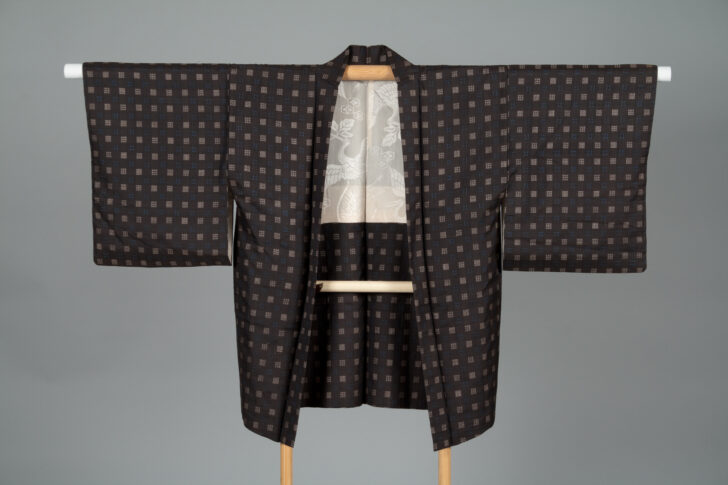Haori
Japanese

Description
Fashioned in the Amami islands of Japan, Oshima Tsumugi silk has long been admired
for its understated beauty, incredible softness, and comfortable lightness suitable for all
seasons. The fabric is created through a remarkable and laborious process involving
two stages of weaving and over 100 rounds of dyeing. First, white silk threads are
woven to mark and bind patterned area with cotton threads, and then disassembled.
The wefts (horizontal threads) and the warps (vertical threads) are separately dyed with
plant juice, taken from a type of locally grown rose bush, and mud. Mud gives shimmer
and tender texture to the silk. After the cotton binds are removed, and sometimes more
colors are added (see the brown sections of some of the patterns in this kimono), the
wefts and the warps are woven into a final product. The entire process can take up to
one year. Despite the high production values and complexities, however, Oshima
Tsumugi kimono can be worn only for non-ceremonial occasions, since woven fabric is
considered to be a less elevated technique than paint-dyed fabric.
Subject Matter:
The checkered exterior patterns are comprised of rice fields (ta) and well (ido) motifs. The inner lining contains cranes, hexagonal, and paulownia leaf motifs.
Tsumugi is a type of soft fabric woven from raw silk, often worn for casual occasions. The typical tsumugi types include Ooshima, Yuki, Shinozawa, Ueda, named after its area of production.
The Haori is a traditional Japanese hip or thigh-length jacket with elongated sleeves that is worn over the kimono. The Haori typically includes an interior lining with a design that is otherwise hidden from view when worn. The haori was originally part of a man’s formal attire, but in the nineteenth century, female entertainers in Edo (modern Tokyo) adopted it as a cloak for outdoor wear in mild weather. By the end of the century, married women of the upper class adopted black crepe silk haori with family crests for formal, public occasions. For much of the twentieth century, the haori has been the standard outerwear for a woman who dresses in a kimono outside the home.
Physical Description:
Dark brown tsumugi haori with beige and blue checkered patterning with a silk off-white inner lining.
Usage Rights:
If you are interested in using an image for a publication, please visit https://umma.umich.edu/request-image/ for more information and to fill out the online Image Rights and Reproductions Request Form.